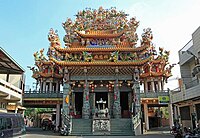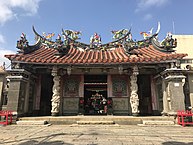Xingang (Chiayi)
|
Xingang 新港 鄉 |
||
 Location of Xingangs in Chiayi County |
||
| State : |
|
|
| County : | Chiayi | |
| Coordinates : | 23 ° 34 ' N , 120 ° 21' E | |
| Area : | 66.0495 km² | |
| Residents : | 31,382 (Apr. 2020) | |
| Population density : | 475 inhabitants per km² | |
| Time zone : | UTC + 8 (Chungyuan time) | |
| Telephone code : | (+886) (0) 5 | |
| Postal code : | 616 | |
| ISO 3166-2 : | TW-CYQ | |
| Community type : | Rural community ( 鄉 , Xiang ) | |
| Structure : | 23 villages ( 村 , Cūn ) | |
| Website : | ||
|
|
||
Xingang ( Chinese 新港鄉 / 新港乡 , Pinyin Xīngǎng Xiang ), also Singang is a rural municipality ( 鄉 , Xiang ) in Chiayi County the Republic of China on Taiwan .
location
Xingang is located in the northwest of Chiayi County on the Jianan Plain , just under two kilometers from the Chiayi city limits . The northern boundary is essentially the Beigang (Beigangxi) river. The neighboring communities are Chiayi Liujiao County in the west, Taibao in the south, Minxiong in the east, and Xikou in the northeast. In northern Yunlin County , Beigang and Yuanchang parishes are adjacent. The distance to the coast is about 16.5 kilometers.
history
Before the beginning of the Chinese settlement, Xingang was inhabited by Austronesian indigenous peoples (Pingpu) of the Hoanya ethnic group . From the 17th century onwards, Han Chinese settlers immigrated from the mainland, most of whom came from the area of today's Zhangzhou in Fujian Province . The area was named Bengang ( 笨港 , Bèngǎng ) - possibly the transliteration of an expression from the Hoanya language. In the Dagregisters van het kasteel Zeelandia of the Dutch East India Company , the place is mentioned under the name Ponkan . In 1750, Bengang was flooded by the Beigang River and separated into a northern part ( Benbeigang , 笨 北港 ) and a southern part ( Bennangang , 笨 南港 ). Due to repeated floods and conflicts with the neighbors, the residents of Bennangang moved the settlement to a little further south during the reign of Jiaqing (1796-1820). The new settlement was named Sinnangang ( 新 南港 - "New Southern Harbor"). In the final phase of the Qing Dynasty , the name was shortened to Singang or Xingang ( 新港 ). During the period of Japanese rule in Taiwan (1895–1945), major administrative reforms took place in 1920. Xingang was formed as a 'village' ( 庄 , Zhuang ) within its current boundaries , but renamed to the similar-sounding Xinxiang ( 新 巷 , Xīnxiàng - "New Alley"), as there were already several other places with the name Xingang in Taiwan, and since Xingang had long since lost his access to the sea through siltation. After Taiwan was taken over by the Republic of China at the end of World War II, it was renamed Xingang and from 1950 Xingang was a rural community ( 鄉 , Xiang ) in the newly formed district of Chiayi.
population
The vast majority of the population are Hoklo ( Minnan speakers). Members of indigenous peoples make up only a very small proportion (65 people at the end of 2019, 0.2%).
| Outline of Xingang |

|
Administrative division
Xingang is divided into 23 villages ( 村 , Cūn ):
1 Daxing ( 大興 村 )
2 Fude ( 福德 村 )
3 Gongqian ( 宮 前 村 )
4 Gonghou ( 宮 後 村 )
5 Datan ( 大 潭村 )
6 Xizhuang ( 西 庄村 )
7 Haiying ( 海 瀛 村 )
8 Gumin ( 古 民村 )
9 Pizi ( 埤 子 村 )
10 Beilun ( 北崙 村 )
11 Nanlun ( 南崙 村 )
12 Zhongzhuang ( 中 庄村 )
13 Gonghe ( 共和 村 )
14 Bantou ( 板 頭村 )
15 Nangang ( 南港 村 )
16 Tanda ( 潭 大村 )
17 Anhe ( 安和 村 )
18 Xibei ( 溪北 村 )
19 Yuemei ( 月眉 村 )
20 Yuetan ( 月 潭村 )
21 Caigong ( 菜 公 村 )
22 Zhongyang ( 中 洋村 )
23 Sanjian ( 三 間 村 )
Agriculture
Agriculture is still very important. Local specialty products are sweet peppers (60 percent of total Taiwanese production in 2017) and tomatoes . Ornamental flowers ( prairie bells ) are also grown, most of which are exported to Japan.
traffic
Xingang is crossed by several district roads. District roads 166 (in the south) and 164 (further north) run in an east-west direction. County road 145A (145 甲) runs in north-south direction and county road 157 runs from south-west to northeast. Provincial road 37 runs from south to Xingang and ends here. A little east of Xingang, the national road 1 (motorway) runs in a north-south direction. The route of the Taiwanese High Speed Railway (THSR) also runs in a straight north-south direction through Xingang, but it has no stop here.
particularities
Xingang has several temples worth seeing. In Jingzhong Temple ( 精忠廟 , Jingzhong Miao ) in the village Dathan whose current equipment dates back to 1923, is Yue Fei revered. The Fengtian Temple ( 奉天 宮 , Fèngtiān gōng ) in the village of Daxing is a Mazu temple in the typical Hokkien style, whose origins go back to the year 1700. In the village of Xibei there is another smaller Mazu Temple, the Liuxing Temple ( 六 興 宮 , Liùxìng gōng ), which dates from 1826. The Shuixian Temple ( 水仙 宮 , Shuǐxiān gōng ), built in 1739, is located in the village of Nangang , the majority of which has been preserved in its original state. The five Daoist sea and water deities Shuixian Zunwang ( 水仙 尊王 ) were originally worshiped here. Later the cult was mainly transferred to Mazu.
![]()
![]()
![]()
![]()
The Beiganxi Iron Bridge ( 北港溪 鐵橋 , Běigǎngxī tiěqiáo ) is an 879-meter-long, 672-mm, iron narrow-gauge railway bridge over the Beigang River, built in 1911 by the Japanese colonial administration. It was in operation for the Zuckerbahn traffic for decades . Passenger traffic was discontinued on August 17, 1982 and, in 1998, freight traffic as well. The bridge has been badly damaged several times in the course of its history by floods.
![]()
Web links
Individual evidence
- ↑ The character 新 is transcribed in Standard Chinese Xīn and Taiwanese (the original local vernacular) Sin .
- ↑ JL Blussé, ME van Opstall, Ts'ao Yung-Ho (ed.): De dagregisters van het kasteel Zeelandia, Taiwan 1629-1662 (= Rijks Geschiedkundige Publicatiën . Volume 195, 229, 233, 241 ). Verlag Martinus Nijnhoff, s'Gravenhage 1986 (Dutch, digitized version with full-text search function at the Huygens Instituut voor Nederlandse Geschiedenis ).
- ^ History. Xingang website, November 8, 2017, accessed May 14, 2020 .
- ↑ 歷史 沿革 (history). Xingang website, accessed on May 14, 2020 (Chinese (traditional)).
- ^ Xingang Township. Chiayi County Government, February 11, 2020, accessed May 14, 2020 .
- ↑ 原住民 戶數 及 人數 Households and Persons of Indigenous People. (xls) Taiwan Ministry of the Interior, accessed May 14, 2020 (Chinese, English).
- ↑ 行政 區域 (administrative regions). Xingang website, accessed on May 14, 2020 (Chinese (traditional)).
- ↑ Singang Produce - An Agricultural Model. Xingang website, November 8, 2017, accessed May 14, 2020 .
- ↑ Jingzhong Temple in Datan Village. Culture and Tourism Authority of Chiayi County, November 8, 2017, accessed on May 15, 2020 (English).
- ↑ 大潭 精忠 廟 ("Datan Jingzhong Temple").文化 資源 地理 資訊 系統 (Academia Sinica Geographical Information System for Cultural Resources), accessed on May 15, 2020 (Chinese (traditional)).
- ↑ County Monument Fongtian Temple. Culture and Tourism Authority of the Chiayi County, November 9, 2017, accessed on May 15, 2020 (English).
- ↑ Liuxing Temple. Culture and Tourism Authority of the Chiayi County, November 9, 2017, accessed on May 15, 2020 (English).
- ↑ 溪北 六 興 宮 (“Xibei Liuxing Temple”).文化 資源 地理 資訊 系統 (Academia Sinica Geographic Information System for Cultural Resources), accessed on May 15, 2020 (Chinese (traditional)).
- ↑ Shuixian Temple. Culture and Tourism Authority of Chiayi County, November 8, 2017, accessed on May 15, 2020 (English).
- ↑ 南港 水仙 宮 (“Nangang Shuixian Temple”).文化 資源 地理 資訊 系統 (Academia Sinica Geographic Information System for Cultural Resources), accessed on May 15, 2020 (Chinese (traditional)).
- ↑ Historic Building- Xingang Taisugar Fuxing Iron Bridge. Culture and Tourism Authority of Chiayi County, November 8, 2017, accessed on May 15, 2020 (English).
- ↑ 古蹟 導覽 (historical tour). Xingang website, accessed on May 14, 2020 (Chinese (traditional)).






